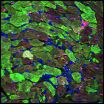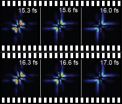(Press-News.org) The enzyme telomerase repairs cell damage produced by ageing, and has been used successfully in therapies to lengthen the life of mice. Now it has been observed that it could also be used to cure illnesses related to the ageing process. Researchers at the Spanish National Cancer Research Centre (CNIO) have for the first time treated myocardial infarction with telomerase by designing a very innovative strategy: a gene therapy that reactivates the telomerase gene only in the heart of adult mice, thus increasing survival rates in those animals by 17 % following a heart attack.
Christian Bär and Bruno Bernardes de Jesús, researchers in Maria Blasco's Group at CNIO, have worked alongside several Units from the CNIO Biotechnology Programme and the teams of Fátima Bosch (the Autonomous University of Barcelona) and Kai Wollert (Hannover Faculty of Medicine, Germany). "Our work suggests that the activation of telomerase could be a therapeutic strategy to prevent heart failure following myocardial infarction," say the authors of the study published today in Nature Communications.
"We have discovered that following a myocardial infarction, hearts that express telomerase show less heart dilatation, better ventricular function and smaller scars from the heart attack; these cardiac events are associated with an increased survival of 17 % compared to control animals," they say.
Furthermore, everything points to cardiomyocytes--the cells responsible for heart beating--being regenerated in those hearts with telomerase, a long searched-for goal in post-heart-attack therapy. The regeneration of heart muscle would counter the formation of scars as a consequence of the heart attack, a tough tissue that hinders cardiac function and increases the likelihood of heart failure.
"One of the aims of cardiology when treating myocardial infarction and preventing heart failure is efficient cardiac regeneration, but up until now there have not been any significant advances in this sense," explain the authors.
They remind us that heart failure is the most common cause of death and illness in the world, and that one of its main risk factors--of cardiovascular disease generally--is ageing: the process not only causes changes to the heart that make it more likely to fail, but it also reduces its capacity to regenerate itself.
GENE THERAPY IN ADULTS
The study published today is part of another in which the same CNIO Group developed a genetic technique, in 2012, to reintroduce the telomerase gene in an adult organism. It was then shown that thanks to their renewed capacity to synthesise telomerase, mice lived 40 % longer. Now the authors explore the hypothesis that, if telomerase delays ageing, it may also combat diseases related to ageing, like heart attacks.
Telomerase is able to reset a cell's biological clock by rebuilding telomeres, the protein hoods that protect the ends of chromosomes. Telomeres progressively shorten every time the cell divides, until they reach a critical length, at which point they cannot carry out their protective function. Then the cell stops dividing and ages. At the whole-body level, telomere shortening leads to ageing-related diseases, including cardiac dysfunction in both mice and human beings.
Telomerase prevents this shortening of the telomeres, but in the vast majority of cells in the body it only does so before birth; adult cells, exceptions aside, do not contain telomerase.
The authors of the study inoculated adult mice with a modified virus that contained telomerase gene between viral genes, so that adult cells could express telomerase once again. In their seminal work in 2012, the reintroduced telomerase gene was perfectly expressed throughout the body. But this time, researchers have infected only the heart and, when they have been sure that the animals were expressing telomerase in the organ, they have induced a heart attack.
"These results show that the activation of telomerase in the adult heart is beneficial for survival in model mice that have suffered acute myocardial infarction, an effect that coincides with cardiac myocardial cells having longer telomeres and the activation of several pathways associated with cardiac protection and regeneration," conclude the authors. This study provides "proof-of-concept for the development of innovative strategies based on the activation of telomerase to treat chronic and acute heart failure," and it opens new avenues for the treatment of other age-related diseases.
The authors of the study--with the help of cardiologist Francisco Fernández-Avilés, Head of Cardiology at the Gregorio Marañón General Hospital--hope to soon be able to test this gene therapy in pigs as a prior step to human trials. Fernández-Avilés said: "this study is impressive due to its ingenuity and methodology, and totally disruptive from the clinical point of view, given that it opens doors we've never explored before to treat heart disease. It is crucial for two reasons: it demonstrates that natural mechanisms for preserving genetic information are involved in myocardial protection and regeneration; and it teaches us that those mechanisms can be reactivated using therapeutic approaches applicable to patients."
INFORMATION:
The research has been funded by the Botín Foundation, Roche, the European Commission (ERC), and the Ministry of Economy and Competitiveness.
Reference article:
Telomerase expression confers cardioprotection in the adult mouse heart after acute myocardial infarction. Christian Bär, Bruno Bernardes de Jesus, Rosa Serrano, Agueda Tejera, Eduard Ayuso, Veronica Jimenez, Ivan Formentini, Maria Bobadilla, Jacques Mizrahi, Alba de Martino, Gonzalo Gomez, David Pisano, Francisca Mulero, Kai C. Wollert, Fatima Bosch, Maria A. Blasco. Nature Communications (2014). doi: 10.1038/ncomms6863
Researchers from North Carolina State University have found a way of binding peptides to the surface of gallium nitride (GaN) in a way that keeps the peptides stable even when exposed to water and radiation. The discovery moves researchers one step closer to developing a new range of biosensors for use in medical and biological research applications.
GaN is a biocompatible material that fluoresces, or lights up, when exposed to radiation. Researchers are interested in taking advantage of this characteristic to make biosensors that can sense specific molecules, or "analytes," ...
This news release is available in German.
Physicists are continuously advancing the control they can exert over matter. A German-Spanish team working with researchers from the Max Planck Institute for Nuclear Physics in Heidelberg has now become the first to image the motion of the two electrons in a helium atom and even to control this electronic partner dance. The scientists are succeeding in this task with the aid of different laser pulses which they timed very accurately with respect to each other. They employed a combination of visible flashes of light and ...
Trophoblasts, cells that form an outer layer around a fertilized egg and develop into the major part of the placenta, have now been shown to respond to inflammatory danger signals, researchers from Norwegian University of Science and Technology (NTNU) found in a recent study published in Journal of Reproductive Immunology December 2014.
The researchers said their findings were an important step in understanding how inflammatory responses in the placenta can contribute to the development of pregnancy disorders such as preeclampsia.
The trophoblast inflammatory response ...
This news release is available in German.
Puebla del Guzman (Andalusia) / Magdeburg. Being part of the mining area Herrerias in Andalusia, deep waters of Pit Lake Guadiana show extremely high concentration of dissolved carbon dioxide (CO2). In the case of a spontaneous ebullition, human beings close-by would be jeopardized. To demonstrate the danger and the possible solution, scientists of the Spanish Institute of Geology and Mining, the University of the Basque Country (UPV/EHU, Bilbao) and the Helmholtz Centre for Environmental Research (UFZ) constructed a pilot ...
Chlorine is a common disinfectant that is used to kill bacteria, for example in swimming pools and drinking water supplies. Our immune system also produces chlorine, which causes proteins in bacteria to lose their natural folding. These unfolded proteins then begin to clump and lose their function. RUB researchers headed by Prof Dr Lars Leichert have discovered a protein in the intestinal bacterium E. coli that protects bacteria from chlorine. In the presence of chlorine, it tightly bonds with other proteins, thus preventing them from coagulating. Once the danger has passed, ...
This news release is available in German. A team of scientists headed by Dr. Florian Bassermann at the III. Medizinische Klinik, TUM Klinikum rechts der Isar, has been investigating mantle cell lymphoma, a subgroup of non-Hodgkin's lymphoma, which, despite new therapies, has poor patient survival rates. "Programmed cell death no longer functions in many lymphoma cells. This causes them to multiply uncontrollably. We urgently need to find out what's going wrong in these cells in order to find new treatment therapies," explains Bassermann.
The scientists started analyzing ...
A new study shows that many patients infected with the hepatitis C virus (HCV) are lost during different stages of health care to manage the disease. This real-life' view of the HCV patient care continuum in a major U.S. urban area is published in Hepatology, a journal of the American Association for the Study of Liver Diseases, and highlights the importance of generating awareness among clinicians and at-risk groups about appropriate HCV testing, referral, support and care.
Despite efforts to manage HCV, it is one of the most prevalent diseases with up to 150 million ...
Hydrogen peroxide (H2O2) is a strong oxidizer and is used as a bleaching agent for hair and teeth, and as a wound disinfectant. In addition, H2O2 also forms in the body, for example as a metabolic product of cellular respiration. It belongs to a group of chemicals called reactive oxygen species (ROS), which scientists suspect to have a damaging effect on cells and their components. For example, they are believed to play a role in carcinogenesis, degenerative diseases, and even aging. Body cells contain large quantities of enzymes called peroxiredoxins that degrade H2O2 ...
Research that provides a new understanding as to why ferrets are similar to humans is set to have major implications for the development of novel drugs and treatment strategies.
Published in the prestigious journal Nature Communications, the research is a collaboration between Professor Michael Jennings and other researchers from the Institute for Glycomics, Griffith University and collaborators at the University of Queensland and the University of Adelaide.
The team has shown for the first time that ferrets share a mutation that was previously thought to be unique ...
ANN ARBOR--In a development that could lead to a deeper understanding of cancer and better early-stage treatment of the disease, University of Michigan researchers have devised a reliable way to grow a certain type of cancer cells from patients outside the body for study.
The new technique is more than three times as effective as previous methods.
Researchers say it's a major step forward in the study of circulating tumor cells, which are shed from tumors and circulate through the blood of cancer patients. They're believed to cause metastasis, the spread of cancer ...



